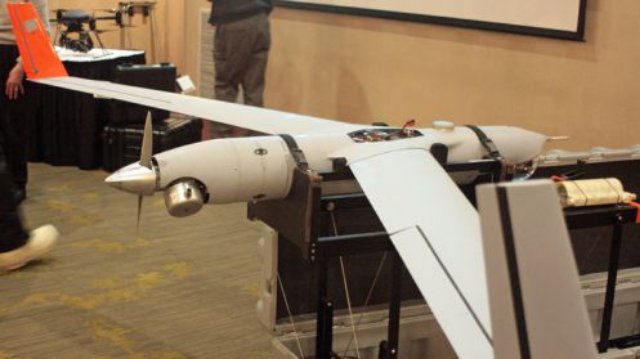
University of Alaska Fairbanks ScanEagle on Display During the Science for Alaska Lecture – Photo:Michelle Strehl/ Sun Star
The UAF Geophysical Institute is hosting their annual Science for Alaska lecture series in order to introduce the Fairbanks community to new technology – the first lecture educated the audience about the use of unmanned aircraft.
The audience at the Westmark Fairbanks Hotel & Conference Center fell silent as Greg Walker, UAF unmanned aircraft research project lead, took the floor and explained how his team accomplishes research missions by using UAS.
Walker is the manager of the Poker Flats Research Range, a division of the UAF Geophysical Institute, and has been designing and making control systems for unmanned aircraft since 1998.
“Our team is attempting to show that unmanned aerial vehicles are a cost-efficient and readily-available tool for research, when manned aircraft is not an option,” Walker said as he stood in front of the audience.
Throughout the presentation, Walker described each of the different UAS the team uses for research.
UAS come in both airplane and helicopter models, and are invaluable tools in many research projects and problems. They have appeared in projects such as assessing the Deepwater Horizon oil spill, examining difficult-to-access BP equipment, mapping Steller sea lions in Dutch Harbor, participating in pathfinder missions in Arctic regions and mapping forest fires.
“My personal belief is that UAS work well for natural resource management,” Walker said. “Survey of climate change studies, emergency response and pathfinder missions.”
For an emergency response mission, the faster a plane is sent out, the better.
“It takes time to inspect and prep a manned aircraft for a mission,” Walker said. “With a unmanned aircraft we are able to prepare quickly if the mission calls for it.”
On top of being able to prepare a UAS quickly, an unmanned aircraft can be used to observe animals in their natural habitat with disturbing them.
“In a manned aircraft, the only pictures of Steller sea lions we get are of their tails,” Walker said. “Instead of acting normally, the sound of a large plane will normally scare them into the water, while a UAS can successfully take pictures of the sea lions acting naturally.”
Because of their size and maneuverability, the projects that used UAS were able to get to altitudes and angles that a manned aircraft could not.
“Sometimes it’s dangerous to put humans out there,” Walker said. “If you have a project that’s hundreds of miles from land, and you have to maintain a low altitude, if you have any problems it’s a good chance you will die.”
However, by using UAS for these missions, the only risk is losing a plane — nowhere near the cost of a human life.
“The planes are fairly cheap,” Walker said. “It’s the computers and programming within the UAS that make them expensive.”
The UAS used by Walker and his team range in price from $300 to $100,000, and perform jobs such as orthographic mapping, high-resolution photography and aerosol analysis.
As well as being somewhat cheap, most of the planes that Walker’s team uses are electric-powered, able to sustain flight for long periods of time, making UAS extremely cost effective.
